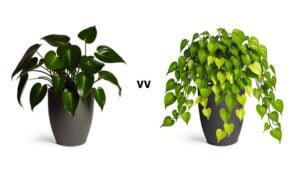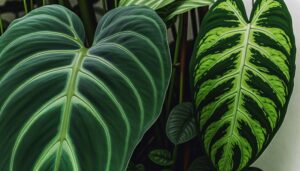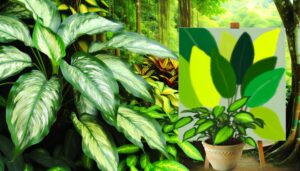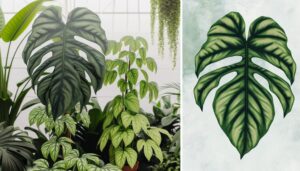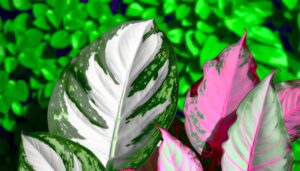Philodendron Mcdowell Vs Gloriosum: Key Difference!
Philodendron Mcdowell and Philodendron Gloriosum, both from the tropical rainforests of South America, demonstrate distinctive characteristics. Mcdowell features heart-shaped, velvety leaves with wavy margins and deeply marked veins, growing vertically up to 1.5 meters annually.
In contrast, Gloriosum exhibits matte-finished, smoother-edged heart-shaped leaves and spreads horizontally at a rate of approximately 30 centimeters per year. Their light and watering needs differ; Mcdowell thrives in 200-400 lumens and consistent moisture, while Gloriosum prefers 400-600 lumens and slight soil drying between watering.
To discover further nuances between these fascinating species, continue exploring their attributes.
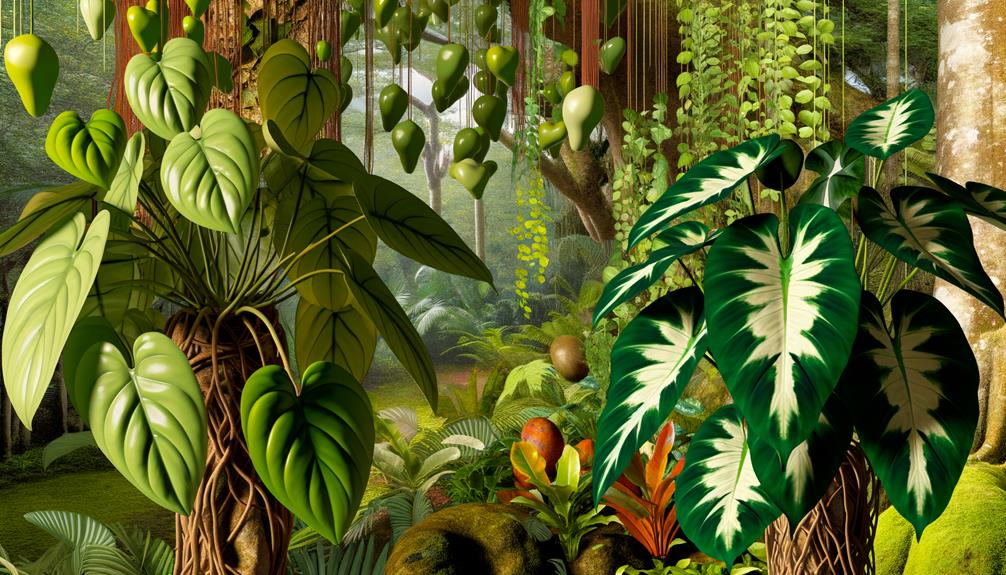
Key Takeaways
- Philodendron Mcdowell has wavy leaf margins, while Gloriosum has smoother edges on their heart-shaped leaves.
- Mcdowell exhibits a vining growth habit, whereas Gloriosum spreads horizontally with a creeping, rhizomatous structure.
- Gloriosum’s leaves are larger compared to Mcdowell’s leaves.
- Mcdowell thrives in moderate light (200-400 lumens), while Gloriosum prefers slightly higher light (400-600 lumens).
- Mcdowell needs watering every 5-7 days, whereas Gloriosum requires watering every 7-10 days, allowing the top soil to dry.
Characteristic of Philodendron McDowell vs Gloriosum
| Characteristic | Philodendron McDowell | Philodendron Gloriosum |
|---|---|---|
| Leaf Shape & Texture | Heart-shaped leaves with prominent, ribbed veins and a leathery texture. | Large, velvety heart-shaped leaves with striking white veins. |
| Leaf Color | Bright green leaves with a slightly glossy finish. | Dark green leaves with contrasting white or light green veins. |
| Growth Habit | Creeping plant, similar to Gloriosum, but more compact and resilient. | Crawling plant, grows horizontally along the soil. |
| Size | Leaves can grow large, up to 2-3 feet, but overall plant stays more compact. | Can produce larger leaves, with some growing up to 3 feet or more. |
| Light Requirements | Prefers bright, indirect light, can tolerate lower light. | Thrives in bright, indirect light, but avoid direct sunlight. |
| Care Difficulty | Moderate care, needs high humidity but is more adaptable to varying conditions. | Moderate care, prefers consistent humidity and bright indirect light. |
| Native Region | Hybrid plant, originally bred for better indoor performance. | Native to Colombia and other tropical regions in South America. |
Origins and History

The origins and history of Philodendron Mcdowell and Philodendron Gloriosum trace back to the rich biodiversity of the tropical rainforests of South America, where these species were first discovered and documented by botanists.
Philodendron Mcdowell, identified primarily in the rainforests of Ecuador, was named in honor of plant collector Robert H. McDowell. This species thrives in humid, lowland forest environments with temperatures averaging 25°C and annual rainfall exceeding 2,500 mm.
Conversely, Philodendron Gloriosum, endemic to Colombia, exhibits a preference for forest understories with similar climatic conditions. Documented in the 19th century, it was classified within the subgenus Philodendron, section Calostigma.
Both species reveal significant insights into the ecological diversity and evolutionary adaptation of aroids in neotropical biomes.
Leaf Shape and Texture
Characterized by striking visual differences, the leaf shape and texture of Philodendron Mcdowell and Philodendron Gloriosum offer a fascinating study in morphological variation within the genus.
- Philodendron Mcdowell: Exhibits large, heart-shaped leaves with prominent, wavy margins. The texture is prominently velvety, measuring up to 60 cm in length and 40 cm in width.
- Philodendron Gloriosum: Features equally large, heart-shaped leaves but with smoother, less undulating edges. The texture is also velvety but presents a slightly more matte finish, with dimensions reaching up to 90 cm in length and 60 cm in width.
- Vein Structure: Both species display pronounced venation, yet Mcdowell’s veins are deeply marked, contributing to its textured appearance.
These distinctions highlight the diversity within Philodendron foliage.
Growth Patterns
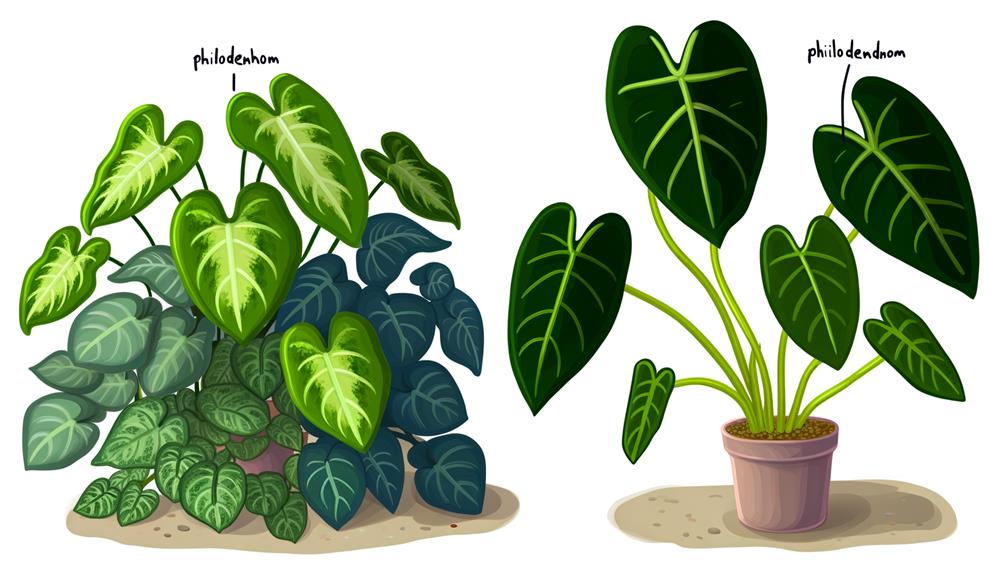
Examining the growth patterns of Philodendron Mcdowell and Philodendron Gloriosum reveals key differences in their climbing and spreading habits, as well as their respective growth rates in various environmental conditions.
Philodendron Mcdowell exhibits a more vining and climbing tendency, utilizing aerial roots to anchor onto supports, achieving vertical growth up to 1.5 meters annually under ideal conditions.
In contrast, Philodendron Gloriosum demonstrates a creeping, terrestrial growth habit, spreading horizontally across the substrate at a slower pace, approximately 30 centimeters per year. This species forms a rhizomatous structure, enabling it to cover ground rather than ascend.
Both species prefer humid, tropical environments with consistent temperatures but differ markedly in their spatial orientation and expansion strategies.
Light Requirements
Both Philodendron Mcdowell and Philodendron Gloriosum exhibit ideal growth when provided with bright, indirect light, though their tolerance for lower light conditions varies.
Philodendron Mcdowell thrives under moderate light intensities, typically ranging between 200 to 400 lumens. Conversely, Philodendron Gloriosum prefers slightly higher light levels, optimally around 400 to 600 lumens.
To visualize their light requirements:
- Philodendron Mcdowell: Flourishes in morning sunlight diffused through translucent curtains.
- Philodendron Gloriosum: Benefits from dappled light under a tree canopy or partial shade outdoors.
- Common Aspect: Both species should avoid direct sunlight to prevent leaf burn and chlorosis.
Understanding these parameters ensures that each plant maintains its vibrant foliage and robust growth.
Watering Needs
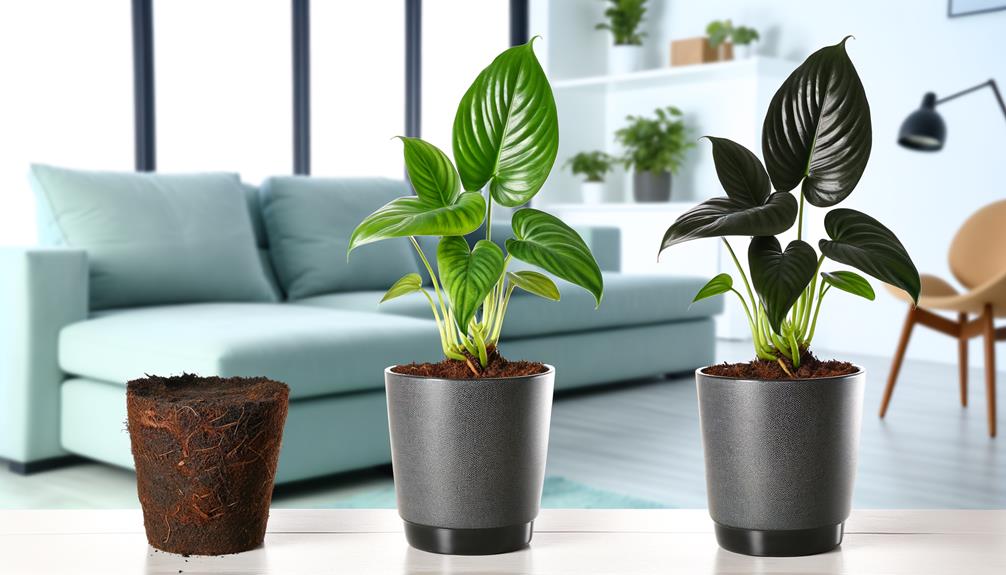
Evaluating the watering needs of Philodendron Mcdowell and Philodendron Gloriosum reveals distinct preferences regarding soil moisture levels and irrigation frequency.
Philodendron Mcdowell thrives with consistently moist soil, requiring watering approximately every 5-7 days, contingent upon ambient humidity and temperature. Overwatering can induce root rot, therefore well-drained substrates are essential.
Conversely, Philodendron Gloriosum favors a slightly drier environment, necessitating watering every 7-10 days. It is critical to allow the top 2-3 centimeters of soil to dry between waterings to prevent waterlogging.
Both species benefit from tepid, dechlorinated water, delivered at the base of the plant to minimize foliar moisture. Accurate moisture meters can be instrumental in maintaining the best hydration levels for these tropical aroids.
Soil and Fertilization
Best soil composition and fertilization strategies are essential for the healthy growth of Philodendron Mcdowell and Philodendron Gloriosum, requiring a well-aerated, nutrient-rich medium with a pH range of 5.5 to 6.5.
Ideal soil mixtures often include:
- 50% peat moss: Enhances moisture retention while providing aeration.
- 30% perlite: Improves drainage and prevents root rot.
- 20% orchid bark: Contributes to structural support and root aeration.
For fertilization, a balanced 20-20-20 water-soluble fertilizer applied bi-monthly during the growing season is recommended. Micronutrients such as magnesium and iron are also essential to prevent deficiencies.
Monitoring and adjusting fertilization based on plant response and growth stage is key to ensuring the best possible health and development.
Common Pests and Diseases
Philodendron Mcdowell and Philodendron Gloriosum are susceptible to a range of pests and diseases, primarily including spider mites, mealybugs, and root rot caused by overwatering. Spider mites (Tetranychidae) feed on plant sap, leading to chlorosis and eventual leaf drop. Mealybugs (Pseudococcidae) excrete honeydew, promoting sooty mold growth. Root rot, induced by waterlogged soil, results from pathogenic fungi such as Pythium spp., causing root necrosis and plant wilting. Preventive measures include maintaining proper humidity (40-60%), regular inspections, and employing systemic insecticides when necessary. Below is a comparative table:
| Pest/Disease | Symptom | Prevention |
|---|---|---|
| Spider Mites | Chlorosis, leaf drop | Increase humidity, miticides |
| Mealybugs | Honeydew, sooty mold | Insecticidal soap, neem oil |
| Root Rot | Root necrosis | Proper drainage, balanced watering |
| Thrips | Distorted growth | Blue sticky traps, insecticides |
| Scale Insects | Leaf yellowing | Horticultural oils, pruning |
Conclusion
To sum up, the Philodendron McDowell and Philodendron Gloriosum, despite their shared lineage, display notable variations in leaf structure, growth patterns, and maintenance needs. The McDowell’s circular, plush leaves stand out against the Gloriosum’s heart-shaped, non-glossy foliage.
Each plant requires precise levels of sunlight, water, and soil quality for optimal growth. Recognizing these distinctions can enhance gardening techniques and enhance the well-being of the plants.
Who wouldn’t admire the intricate charm and distinct traits of these extraordinary aroid species?

